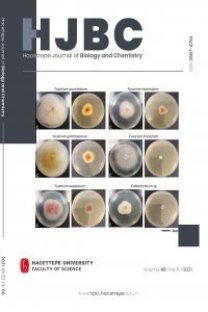Balda Polen Tiplerini Belirlemek için Moleküler Yaklaşım: DNA Barkodlama
Molecular Approach to Detecting Pollen Types In Honey: DNA Barcoding
___
- 1. Turkish Food Codex Communiqué on Honey (No: 2012/58). Turkish food codex communiqué on honey (No: 2012/58) http://wwwresmigazetegovtr/eskiler/2012 /07/20120727- 12htm
- 2. R.H. Luchese, E.R. Prudêncio, A.F. Guerra, Honey as a functional food, In Honey Analysis, InTech, 2017.
- 3. P. Marchand, Statistical Methods for the Detection and space-time monitoring of dna markers in the pollen cloud, Doctoral dissertation, UC Berkeley, 2013.
- 4. S.A. Jain, F.T.D. Jesus, G.M., Marchioro, E.D.D. Araújo, Extraction of DNA from honey and ıts amplification by PCR for botanical identification, Food. Sci. Technol., 33 (2013) 753-756.
- 5. A. Valentini, C. Miquel, P. Taberlet, DNA barcoding for honey biodiversity, Diversity., 2 (2010) 610-617.
- 6. M. Kempf, S. Heil, I. Hasslauer, L. Schmidt, K. von der Ohe, C. Theuring, A. Reinhard, P. Schreier, T. Beuerle, Pyrrolizidine alkaloids in pollen and pollen products, Mol. Nutr. Food. Res., 54 (2010) 292-300.
- 7. M. Kempf, A. Reinhard, T. Beuerle, Pyrrolizidine Alkaloids (PAS) in Honey and pollen-legal regulation of pa levels in food and animal feed required, Mol. Nutr. Food. Res., 54 (2010) 158-168.
- 8. B. Çöl, M. Karaali, çam balında farklı DNA izolasyon tekniklerinin değerlendirilmesi, MJST., (2016) 152-155.
- 9. I. Escriche, M. Kadar, M. Juan-Borrás, E. Domenech, Using Flavonoids, Phenolic compounds and headspace volatile profile for botanical authentication of lemon and orange honeys, Food. Res. Int., 44 (2011) 1504-1513.
- 10. I. Hermosin, R.M. Chicon, M.D. Cabezudo, Free amino acid composition and botanical origin of honey, Food Chem., 83 (2003) 263-268. 15.
- 11. R. Fernandez-Torres, J.L. Perez-Bernal, M.A. Bello-Lopez, M. Callejon-Mochon, J.C. JimenezSanchez, A. Guiraum-Perez, Mineral content and botanical origin of Spanish honeys. Talanta., 65 (2005) 686-691.
- 12. E. Anklam, M. Lipp, B. Radovic, E. Chiavaro, G. Palla, Characterisation of Italian vinegar by pyrolysis–mass spectrometry and a sensor device (‘electronic nose’), Food Chem., 61 (1998) 243–248.
- 13. V. Kaškonienė, P.R. Venskutonis, Floral markers in honey of various botanical and geographic origins: a review, Compr. Rev. Food. Sci. Food. Saf., 9 (2010) 620–634.
- 14. J. Hawkins, N. de Vere, A. Griffith, C.R. Ford, J. Allainguillaume, M.J. Hegarty, L. Baillie, B. Adams-Groom, Using DNA metabarcoding to ıdentify the floral composition of honey: a new tool for ınvestigating honey bee foraging preferences, PLoS. One., 10 (2015) 1-20.
- 15. M. Casiraghi, M. Labra, E. Ferri, A. Galimberti, F. De Mattia, DNA Barcoding: A six-question tour to ımprove users’ awareness about the method, Brief. Bioinform., 11 (2010) 440–453.
- 16. A. Sandionigi, A. Galimberti, M. Labra, E. Ferri, E. Panunzi, D.E.F. Mattia, M. Casiraghi, Analytical approaches for DNA barcoding data – how to find a way for plants?, Plant. Biosyst., 146 (2012) 805–813.
- 17. I. Bruni, A. Galimberti, L. Caridi, D. Scaccabarozzi, F. De Mattia, M. Casiraghi, M. Labra, A DNA barcoding approach to ıdentify plant species in multiflower honey, Food Chem., 170 (2015) 308-315.
- 18. C. Olivieri, I. Marota, F. Rollo, S. Luciani, Tracking plant, fungal, and bacterial DNA in honey specimens, J. Forensic. Sci., 57 (2012) 222–227.
- 19. A. Ozkök, Ç.İ. Karaaslan, H. Akel. Determining plant origin in the honey with dna based methods, 45 th Apimondia International apicultural congress, September 29 - October 4, İstanbul – Turkey, 122, 2017.
- 20. A. Ozkök, H. Akel, D. Canlı. Ç. Karaaslan, Bal analizinde yeni nesil DNA dizi analizi metodunun kullanımı ve validasyonu, Tarımsal Araştırmalar Genel Müdürlüğü (TAGEM), Proje numarası: TAGEM-16/AR-GE/31, 01.09.2016-01.09.2018.
- 21. A. Galimberti, F. De Mattia, A. Losa, I. Bruni, S. Federici, M. Casiraghi, S. Martellos, M. Labra, DNA barcoding as a new tool for food traceability. Food. Res. Int., 50 (2013) 55–63.
- 22. P. Manivanan, S.M. Rajagopalan, M. Subbarayalu, Studies on authentication of true source of honey using pollen DNA barcoding, J Entomol. Zool. Stud., 6 (2018) 255-261.
- 23. M. Saravanan, G. Mohanapriya, R. Laha, R. Sathishkumar, DNA barcoding detects floral origin of Indian honey samples, Genome., 62 (2019) 341-348.
- 24. V.J. Utzeri, A. Ribani, G. Schiavo, F. Bertolini, S. Bovo, L. Fontanesi, Application of next generation semiconductor based sequencing to detect the botanical composition of monofloral, polyfloral and honeydew honey, Food Control., 86 (2018) 342-349.
- 25. I. Laube, H. Hird, P. Brodmann, S. Ullmann, M. Schone- Michling, J. Chisholm, H. Broll, Development of primer and probe sets for the detection of plant species in Honey, Food Chem., 118 (2010) 979-986.
- 26. R. Lalhmangaihi, S. Ghatak, R. Laha, G. Gurusubramanian, N.S. Kumar, Protocol for optimal quality and quantity pollen DNA ısolation from honey samples. J. Biomol. Tech., 25 (2014) 92-95.
- 27. R.C. Laha, S. Mandal, L. Ralte, L. Ralte, N.S. Kumar, G. Gurusubramanian, R. Satishkumar, R. Mugasimangalam, N.A. Kuravadi, Meta-Barcoding in combination with palynological ınference İs a potent diagnostic marker for honey floral composition. AMB. Express., 7 (2017) 1-8.
- 28. S. Soares, L. Grazina, J. Costa, J.S. Amaral, M.B. Oliveira, I. Mafra, Botanical authentication of lavender (Lavandula spp.) honey by a novel dna-barcoding approach coupled to high resolution melting analysis, Food Control., 86 (2018) 367-373.
- 29. L.F. Cuevas-Glory, J.A. Pino, L.S. Santiago, E. Sauri-Duch, A review of volatile analytical methods for determining the botanical origin of honey, Food Chem., 103 (2007) 1032- 1043.
- ISSN: 2687-475X
- Yayın Aralığı: 4
- Başlangıç: 1972
- Yayıncı: Hacettepe Üniversitesi, Fen Fakültesi
Esin AKBAY, Y. Doruk ARACAGÖK, Ali Hakan GÖKER, Mehmet Ali ONUR, Nilüfer CİHANGİR
Mutlu SÖNMEZ ÇELEBİ, Kübra ÖZTÜRK, Mehmet DUMANGÖZ
Akut Apandisitlerde Hücresel Antioksidan Savunma Sisteminin Oksidatif Stres Üzerindeki Rolü
Yeliz DEMİR, Ayetullah TEMİZ, Ayşe ALBAYRAK, Yavuz ALBAYRAK, Şükrü BEYDEMİR, Mesut IŞIK, Hatice Esra DURAN, Adem ASLAN, Yılmaz ÖZDEMİR
Dursun SARAYDIN, Şenol KUBİLAY, Kadir SELÇUK
Gülbin KURTAY, Fatma Şeyma GÖKDEMİR, Başar KARACA, Ege EDİZ, Sümer ARAS, İlker BÜYÜK
Hacettepe Üniversitesi Beytepe Yerleşkesinin Karasal Omurgalı Faunası
Şafak BULUT, Mehmet Kürşat ŞAHİN, Zafer AYAŞ, Burak AKBABA
Ayetullah TEMİZ, Mesut IŞIK, Yavuz ALBAYRAK, Hatice Esra DURAN, Adem ASLAN, Yeliz DEMİR, Ayse ALBAYRAK, Mesut IŞIK, Şükrü BEYDEMİR
